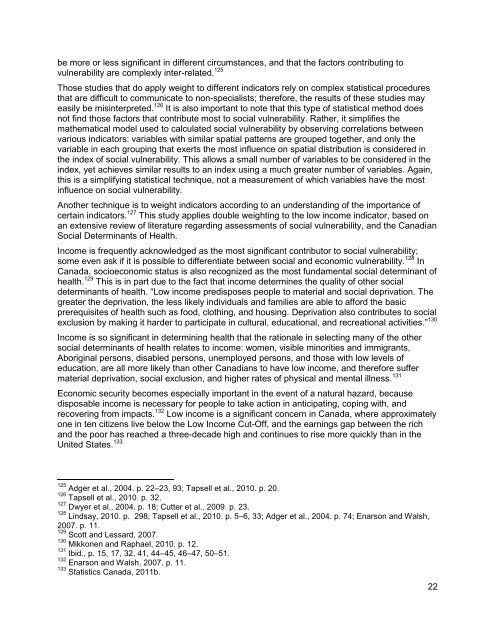Lunenburg Part 2 - Section 5 - Social Vulnerability - August 30.pdf
Lunenburg Part 2 - Section 5 - Social Vulnerability - August 30.pdf
Lunenburg Part 2 - Section 5 - Social Vulnerability - August 30.pdf
You also want an ePaper? Increase the reach of your titles
YUMPU automatically turns print PDFs into web optimized ePapers that Google loves.
e more or less significant in different circumstances, and that the factors contributing to<br />
vulnerability are complexly inter-related. 125<br />
Those studies that do apply weight to different indicators rely on complex statistical procedures<br />
that are difficult to communicate to non-specialists; therefore, the results of these studies may<br />
easily be misinterpreted. 126 It is also important to note that this type of statistical method does<br />
not find those factors that contribute most to social vulnerability. Rather, it simplifies the<br />
mathematical model used to calculated social vulnerability by observing correlations between<br />
various indicators: variables with similar spatial patterns are grouped together, and only the<br />
variable in each grouping that exerts the most influence on spatial distribution is considered in<br />
the index of social vulnerability. This allows a small number of variables to be considered in the<br />
index, yet achieves similar results to an index using a much greater number of variables. Again,<br />
this is a simplifying statistical technique, not a measurement of which variables have the most<br />
influence on social vulnerability.<br />
Another technique is to weight indicators according to an understanding of the importance of<br />
certain indicators. 127 This study applies double weighting to the low income indicator, based on<br />
an extensive review of literature regarding assessments of social vulnerability, and the Canadian<br />
<strong>Social</strong> Determinants of Health.<br />
Income is frequently acknowledged as the most significant contributor to social vulnerability;<br />
some even ask if it is possible to differentiate between social and economic vulnerability. 128 In<br />
Canada, socioeconomic status is also recognized as the most fundamental social determinant of<br />
health. 129 This is in part due to the fact that income determines the quality of other social<br />
determinants of health. “Low income predisposes people to material and social deprivation. The<br />
greater the deprivation, the less likely individuals and families are able to afford the basic<br />
prerequisites of health such as food, clothing, and housing. Deprivation also contributes to social<br />
exclusion by making it harder to participate in cultural, educational, and recreational activities.” 130<br />
Income is so significant in determining health that the rationale in selecting many of the other<br />
social determinants of health relates to income: women, visible minorities and immigrants,<br />
Aboriginal persons, disabled persons, unemployed persons, and those with low levels of<br />
education, are all more likely than other Canadians to have low income, and therefore suffer<br />
material deprivation, social exclusion, and higher rates of physical and mental illness. 131<br />
Economic security becomes especially important in the event of a natural hazard, because<br />
disposable income is necessary for people to take action in anticipating, coping with, and<br />
recovering from impacts. 132 Low income is a significant concern in Canada, where approximately<br />
one in ten citizens live below the Low Income Cut-Off, and the earnings gap between the rich<br />
and the poor has reached a three-decade high and continues to rise more quickly than in the<br />
United States. 133<br />
125 Adger et al., 2004. p. 22–23, 93; Tapsell et al., 2010. p. 20.<br />
126 Tapsell et al., 2010. p. 32.<br />
127 Dwyer et al., 2004. p. 18; Cutter et al., 2009. p. 23.<br />
128 Lindsay, 2010. p. 298; Tapsell et al., 2010. p. 5–6, 33; Adger et al., 2004. p. 74; Enarson and Walsh,<br />
2007. p. 11.<br />
129 Scott and Lessard, 2007.<br />
130 Mikkonen and Raphael, 2010. p. 12.<br />
131 Ibid., p. 15, 17, 32, 41, 44–45, 46–47, 50–51.<br />
132 Enarson and Walsh, 2007. p. 11.<br />
133 Statistics Canada, 2011b.<br />
22














